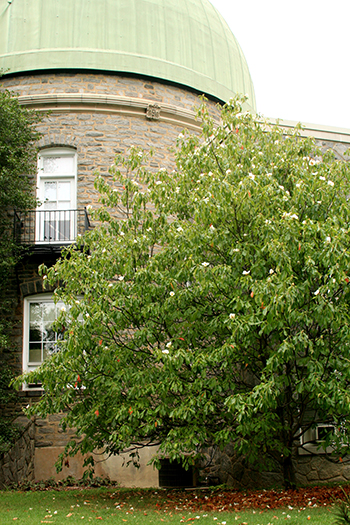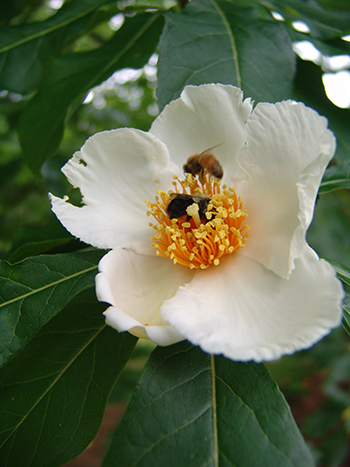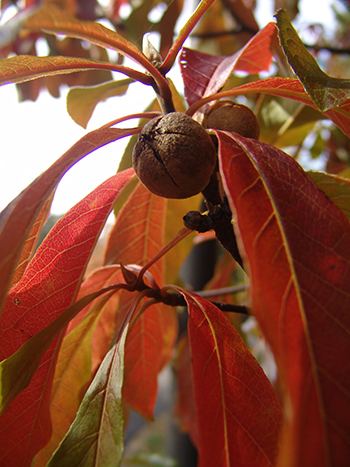Franklinia alatamaha
![Franklinia alatamaha JTB [2]](/wp-content/uploads/2016/07/Franklinia-alatamaha-JTB-2-350x467.jpg) This July marks the 240th anniversary of the signing of the United States Declaration of Independence, cutting ties with the tyrannical imperial monarchy that was Great Britain in an effort to create a new independent nation of the unified 13 colonies. Because of this anniversary, it seems apropos to talk about a plant that has ties to some important characters from that period in American history.
This July marks the 240th anniversary of the signing of the United States Declaration of Independence, cutting ties with the tyrannical imperial monarchy that was Great Britain in an effort to create a new independent nation of the unified 13 colonies. Because of this anniversary, it seems apropos to talk about a plant that has ties to some important characters from that period in American history.

Franklinia grows as single-trunk or, sometimes, a suckering multi-stem shrub with a loosely pyramidal crown. photo credit: D. Mattis
The history of the discovery Franklinia alatamaha is tied to the history of two Philadelphia native botanists, John Bartram and his son William Bartram, as well as their relationship with the well-known Benjamin Franklin. John Bartram is sometimes referred to as “the father of North American botany,” collecting and introducing specimens from North America to the Europeans. Of humble beginnings as a Quaker farmer, Bartram began collecting plants from around his farm. In the mid-1760s Benjamin Franklin and Peter Collinson lobbied to King George III of Britain for Bartram to be appointed the Royal Botanist of North America with an annual pension. In the years until Bartram’s death in 1777, his sample collections and seeds were sent to Kew, Oxford, and Edinburgh.

The flowers of Franklinia resemble Camellia blooms, having five bright white petals and a deep yellow center; the flowers have a sweet fragrance from late Summer to early Fall. photo credit: R. Robert
In 1765 Bartram and his son William discovered the only known home of extant Franklinia growing in a small area along the Altamaha River in Georgia. Returning alone in 1773, William Bartram collected and successfully propagated seeds at Bartram’s Gardens in Philadelphia, from which all existing F. alatamaha are derived. Found to be unlike any other previously described genus, William Bartram named it in honor of Benjamin Franklin, a long-time friend of his father.
Sometimes commonly referred to as the Ben Franklin Tree, Franklinia grows as single-trunk or, sometimes, a suckering multi-stem shrub with a loosely pyramidal crown. It is a monotypic genus in the tea family Theaceae, bearing some resemblance to Stewartia and Gordonia. The flowers of Franklinia resemble Camellia blooms, having five bright white petals and a deep yellow center; the flowers have a sweet fragrance from late Summer to early Fall. Franklinia has ridged, textured bark that is gray with white lines. Unfortunately, they are notoriously finicky trees that will not survive in heavy soils. They prefer a humus-rich, acidic soil with good drainage, similar to the demands of Kalmia or some Rhododendron. They will stand full to part sun and should be kept protected from strong winds.
A few very nice specimens can be seen growing here at the Scott Arboretum on the south side of the Sproul Observatory in the Tree Peony collection. Very few cultivars of Franklinia alatahama exist and none differ much from the species.





![Franklinia alatamaha JTB [3]](/wp-content/uploads/2016/07/Franklinia-alatamaha-JTB-3-400x300.jpg)
Lynn Gee
Posted at 15:45h, 28 SeptemberCan you tell me what the best time to prune a Franklinia is? We have a beautiful specimen in Rose Valley’s Pew Park, and are seeking advice before pruning this tree. Lynn Gee
Gavin Dillard
Posted at 21:34h, 05 OctoberFranklinia leaves can be harvested for tea, but I can find no more information than this. The trees do beautifully here in Black Mountain, NC, on my tea farm Has anyone any information on harvesting and tea-making from the tree?
Becky Robert
Posted at 14:56h, 07 OctoberThis is the first I’ve heard of using Franklinia to make tea. Given their overall rarity its not really a tree I’d see most people having an excess of for harvesting.
Sincerely,
Josh Coceano
Horticulturist
Scott Arboretum